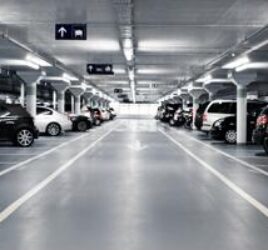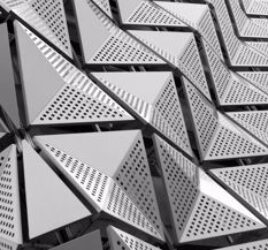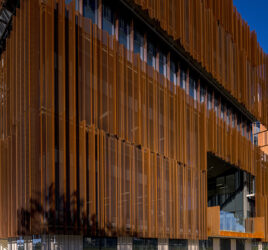
Looking into perforated metal: what we do with hundreds of thousands of holes
The various outcomes of perforating metal are an important aspect of what we produce here at Locker Group, and an area in which we have a lot of experience. We thought it was worth taking a closer look at what it is, how it works and what we can do with this lightweight, versatile product.
The perforation process: What happens?
As Mert Tavsanli, Locker Group’s Perforation Manager, describes it, perforation is done with hydraulic machines that “basically consist of a punch and a die.” The punch penetrates the material, pushes out the slug (the excess metal) through the die, and creates a hole.
Mass perforation machines can punch up and down anywhere from 120 hits per minute up to 500 hits per minute, making two to four rows of perforations with every hit, thus creating hundreds of thousands of holes in minutes. These are not used for every project, however; a lot of architectural products will be manufactured using a linear punch press. The pattern can be made using standard dies, or customised tools if the project demands.
Although the bulk of the perforation we do at Locker Group is to aluminium and steel, the process can be applied to other metals such as brass or copper, and also non-metal products like MDF, plywood, plastics like polyethylene and polypropylene, and polycarbonate materials.
“Effectively we can punch any malleable material” says Mert.
 Pic-Perf is an aesthetic application of the perforation process.
Pic-Perf is an aesthetic application of the perforation process.Pic-Perf – an aesthetic evolution
We’ve adapted the perforation process to create our Pic-Perf product, which uses varying sized holes to recreate a figurative or abstract image in a perforated sheet. According to Mert, the difference between Pic-Perf and regular perforation isn’t so much about the punching technique as the preparation and digital file creation leading up to it. A customer will supply an image which is translated into a digital file suitable for the perforation process. This file is fed into the programming software and the image is applied to the metal in the same way as regular perforations.
What happens to the holes
What happens to the metal that’s punched out of the sheet?
“It’s all recycled,” says Mert. “It goes to a foundry where it’s melted down and reused. A lot of it used to be recycled into car parts for the automotive industry, but now that’s gone they’re finding other homes for it.”
The benefits of perforation
The strength of perforated metal comes from its versatility and customisability. While there are plenty of pre-defined die shapes, a unique die shape is also a possibility.
“If you can draw it, you can make the hole just about whatever shape you like,” says Mert.
Perforated metal often fills a dual role: not only is it an aesthetic device, it is also functional.
Once the perforation is done the sheets themselves offer a range of applications. You can leave a border or a solid edge around the perforations, which makes it easier to work with and easier to fix to a structure. Unlike some other screening materials, perforated metal doesn’t need to be put into a frame, making it more cost effective.
Curving and folding the sheets can create interesting visual devices, and it also has the structural benefit of adding rigidity, which means fewer supports are necessary.
Around 95 per cent of Locker Group’s work for architectural applications is aluminium panels, which are light and pliable. “It has great anti-corrosion characteristics so it lasts for a long long time,” Mert says. “You could put perforated aluminium into an area with a design life of 50 years plus, easily.”
The lightweight nature of aluminium also has the benefit of reducing the load put on a building by the sheets and their supports.
MCG Sports Bar – Lockergroup Pic Perf #MCG #architecture pic.twitter.com/d5cc9HKpkU
— Locker Group (@LockergroupANZ) June 10, 2014
The uses of perforated metal – where does it end up?
Perforated metal has a huge range of uses, which can broadly be separated into industrial and architectural applications.
Some of its industrial uses include watering the pulp in paper mills, crushing and squeezing sugar cane, shielding electrical devices to reduce EMI/RFI radiation and as speaker grills or lining on transmissions in motor vehicles.
In architectural projects our perforated metal sheets have been used for ceiling tiles, balustrades, privacy screens, partitions, infill panels on bridges, sunscreens, decorative screens and facades. Perforated metal often fills a dual role: not only is it an aesthetic device, it is also one that has a functional purpose – usually reducing sunlight or moderating sound in a space.
Atmosphere – sustainable sun protection
Our Atmosphere facade is made of perforated sheets supported on stainless steel cables. The facade is held out from the building’s surface where it can limit the effects of direct sunlight without interrupting visibility from within. The aluminium sheets are folded in one of our standard configurations designed to optimise sustainability, visibility or ventilation. These configurations can also be customised to suit individual projects.
Perforation is a widely applicable process, and the results can have any number of uses. We’re proud that our product is used in such a varied and exciting range of projects. But perforation isn’t all we do at Locker Group. To talk about the products we supply and how they could help your project or business, please get in touch today.




